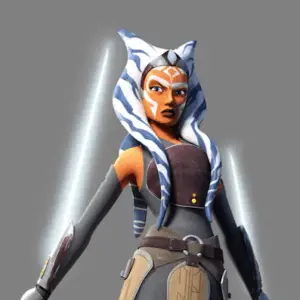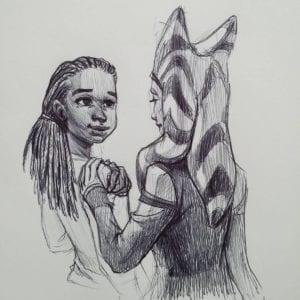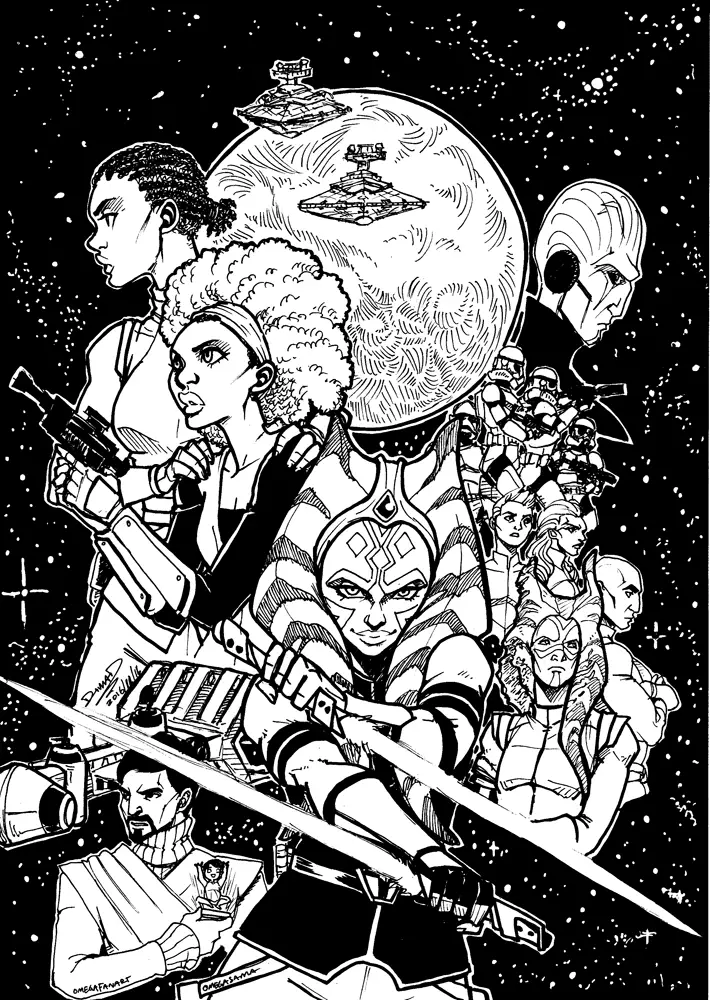A Review of Star Wars: Ahsoka
Do you like queer ladies in space? Queer women of color? This book has a sapphic black space farmer. And possibly another queer character who is kind of a Jedi and also an alien. Fine. It’s Ahsoka (more below). Do you like diverse casts, including women and people of color? Ahsoka has two women of color, three aliens, one white woman, and two men of color as primary and secondary protagonists to one white male.

Do you like YA science fiction that grapples with grief, war, PTSD, healing and found family? Ahsoka is a war veteran and Jedi genocide survivor with survivor’s guilt who learns how to trust and open up to the Force again through new friends, found family, and a low key love interest. Do you hate love triangles? Same. Good thing there are none! Do you like peripheral novels in a known universe about characters that deserve more attention and love? If any or all of these are true, then you really should read Ahsoka.
Don’t know who Ahsoka is? Don’t worry. (Hint: she’s Anakin Skywalker’s padawan from The Clone Wars.) I’d watched maybe two episodes of The Clone Wars beforehand, which was enough to give her character context. I lacked details about what led her to leave the Jedi Temple and start off on her own, but never felt out of my depth. Basically, don’t let not knowing much about Ahsoka Tano hold you back. You’ll know everything you need to by the end of the book, and any further details you can look up on Wookieepedia. Or, you know, hit up your local Star Wars nerd friend. I know at least five.
Anyway, Ahsoka Tano. She’s awesome, and so is her book.
What I Loved
Did I mention queer ladies in space? Mad props to E. K. Johnston for giving us a queer woman of color as a protagonist in a Star Wars novel. Kaeden Larte walks into Ahsoka’s life in the cutest of meet cutes, and won me over immediately when she told her story about fighting with a thresher. The potential romantic nature of her relationship with Ahsoka underscores their interactions from the beginning in a way that is somehow both subtle and not. My friend had told me about the queer coding, but I kind of didn’t believe her until I read it for myself.
Kaeden has known Ahsoka for all of five minutes before she sits on her bed. Ahsoka even mentally remarks on how intimate a gesture it is coming from someone she barely knows. The situation is not at all predatory, I promise—it’s actually innocent and charming. It’s how Kaeden shows Ahsoka she’s accepted into the community.
Nevertheless, the gesture of acceptance and friendly intimacy does have romantic undertones that are carried on throughout the rest of their interactions. That meet cute I mentioned? It totally echoes the trope from western movies of the lone gunman coming into town and meeting up with the hardworking but fiery banker’s/preacher’s/farmer’s daughter who will help him rid the town of outlaws. Ahsoka rescues Kaeden not once, but three times in a delightful f/f spin on the damsel in distress trope. At one point, Kaeden mentions how much she likes Ahsoka’s ‘strong but delicate’ physiology (not even joking). If Ahsoka were male, pretty much every reader would perceive him as Kaeden’s white knight.
“[Ahsoka] wasn’t broad-shouldered like Neera or tall like Vartan, and she didn’t have years of experience working in the field to bolster her strength, but somehow she was clearly very strong though she looked delicate. Maybe it was a Togruta thing. Kaeden didn’t know much about their physiology, but she liked it.”—p.135
Moreover, everyone in the story knows about Kaeden’s not-even-a-secret crush on Ahsoka. Kaeden’s friends and sister tease her about it more than once and use it to question her objectivity about Ahsoka’s behavior. Even the Imperial aggressors seem to have an inkling that these gals are not just pals, going after Kaeden to get to Ahsoka. The only oblivious one is Ahsoka herself—which is hilarious because Ahsoka’s Force talent is her ability to read people—and herein lies the question regarding her status as a woman loving woman (wlw) character.
Kaeden’s interest is pronounced and acknowledged in canon. Ahsoka’s is murkier. Her reaction to Kaeden’s blurted profession of interest is mild confusion and does not admit to having feelings for Kaeden in canon. She never outright rejects Kaeden either, though. Their relationship ends with Ahsoka telling Kaeden that she (Ahsoka) has work to do in the rest of the galaxy but that they might meet again.
There are several different ways to read this. On the one hand, Ahsoka’s headspace frequently reminds me of Katniss Everdeen’s from The Hunger Games. The focus on her trauma, grief, and healing overshadows any potential romantic interest at this point in her life, but does not entirely exclude it were the timing better.
Honestly, I could see her going a variety of ways. She could be straight or bi, given that her other subtextual romantic interest from Star Wars: Rebels is male. I could even see asexual and quite possibly biromantic. I’m not a huge fan of labeling characters in novels that don’t label themselves, so I’ll leave Ahsoka’s label up to preference. I think of her as queer, and I think there’s good canon evidence for it.
Ahsoka’s choice to use scrap metal from Kaeden’s broken thresher in a significant (and spoilery) way when only one of the other metal pieces has a known source is…leading. Still, your mileage may vary. I’m so thankful for the f/f subversion of the hero/damsel trope I don’t even mind the ambiguity.
“[Ahsoka] was, she reminded herself, not trying to make friends, particularly not friends who were at perfect ease sitting on her bed. That sort of thing bespoke a level of intimacy in most cultures. The Jedi Temple was not a place where such things were encouraged and Ahsoka never felt motivated strongly enough to go around the rules the way certain others had.”—p.35-36
Speaking of Ahsoka’s head space, that is the other thing I liked most about this novel. When we meet Ahsoka, she has been on the run from Order 66—the death order for all the Jedi that came at the end of the Clone Wars—for a year. She cannot sense any of the other Jedi, so as far as she knows, she’s the last survivor. Those who have seen the original Star Wars trilogy know that Obi Wan and Yoda survived and went into hiding, but Ahsoka doesn’t. She’s alone, lost, adrift, wracked with grief, and on the run from the Empire. The flashback format works well to communicate her past pain as still a part her present psyche.
Compound this with the fact that she left the Jedi Temple before it was destroyed, and you have survivor’s guilt the size of the Death Star. She blames herself for betraying the Jedi Temple and being alive, but she’s only alive because she left. Her rescue from slavery by the Jedi as a toddler complicates her psychology further. The Jedi were her found family; Anakin and Obi Wan, her adopted fathers (she talks about them that way, it’s adorable and heartbreaking). When the story begins, she’s lost literally everything, even her lightsabers, which symbolize both her faith and her perception of her purpose in the galaxy.

She begins in grief and moves toward hope. We see Ahsoka learn to pick up the pieces of her broken self and put them back together. Like Legend of Korra Book 4, Ahsoka explores the inner life of a woman coping with grief, trauma, and PTSD. Also like Korra, her healing arc comes in stages, and she makes mistakes along the way. She’s not perfect, but she’s healing. There’s one scene at the end that I won’t spoil for you but goddamn. It perfectly encapsulates her journey and newfound wholeness and purpose after defeating one of the Imperial agents. You’ll know which one if you read it.
I like how the novel handles the disparity between Ahsoka’s perception of the Clone Troopers, whom she knew personally, and that of the general populace. It’s an intriguing contrast that Finn continues to nuance in The Force Awakens. I also appreciate how this and other new canon materials question the Jedi “no attachments” ideology. I would not be surprised if it gets completely dismantled eventually, and I’m here for that 100%. Ahsoka represents an exploration of a new kind of relationship with the Force outside of the Jedi/Sith dichotomy, and her pursuit of balanced attachment highlights this. It’s a more nuanced approach, and I hope the trend continues.
Other major highlights include a deeper understanding of the marginalization of nonhuman species within the Empire, an adorable force sensitive child (Hedala Fardi) that I want to have her own novel, Obi-Wan and Anakin feels in flashbacks, Bail Organa showing us where Leia gets her diplomatic and political skills, Johnston reminding the audience that R2-D2 belonged to Padme before Anakin, a fascinating explanation for the red color of Sith lightsabers, and toddler Leia. Also, we get Ahsoka being a skilled tactician, strategist, and fighter as well as a happily mediocre mechanic. It’s rare that books allow any characters, much less women, be merely adequate at any skill, so I appreciate it.
Some Nitpicks
While most of the story occurs in the third person perspective of Ahsoka, Johnston also uses other points of view. Most of them contribute to the narrative and deepen characterization, like Kaeden, Miara, and Bail. My main issue is with Jenneth Pilar, who I think could be done away with entirely. He adds nothing to the characterization of the Empire that we do not already know, i.e., that it’s exploitative and destructive to indigenous life and cultures.
Worse, he gives away plot relevant details that lessen the tension in Ahsoka’s narrative. He tells the reader why the Empire seeks out Raada prior to Ahsoka running into them, and it has nothing to do with Ahsoka. Her perfectly natural fear that they’re after her and that she’s once again engendered innocent lives therefore lacks dramatic tension. Her subsequent relief that they’re not there for her fails to satisfy. The same tension deflating plot reveal occurs twice more in the rest of the novel, once again with Pilar and once with Bail Organa. It’s not enough that I didn’t enjoy the plot, but Ahsoka’s experience could have been more vivid and cathartic without him.

The only reason I can think of for including this character is that he adds a face to the antagonists for the first half of the novel, after which he’s displaced by a Sith Inquisitor. Could this not have been accomplished from the perspective of the military officer in charge of the mission? This book is ripe for a green young officer, chafing at the backwater assignment of Raada but eager for promotion that a successful completion of this mission will bring him. He could complain about how peaceful and easy the assignment was meant to be, only to be stymied again and again by the belligerent citizens of Raada. Instead, we got a number crunching bureaucrat who gives away the plot and cuts his losses before he can face any recriminations for his actions.
His wasn’t the only point of view shift that underwhelmed. More than once at the end of a chapter, the point of view shifts to a tertiary character for the final few paragraphs after the main character has ‘left’ the action. It’s a reasonable storytelling choice with inconsistent results. The lack of visual cue can be mildly jarring since major shifts have a line break to indicate their presence.
Some shifts work better than others, too. Hedala’s paragraphs worked better than Hoban’s, for example. For me, the success of the shift depended on what information the character conveyed. If it added no new information, or offered information that could have been conveyed equally well in conversation with a main point of view character, the shift felt unnecessary. I understand that Star Wars novels typically utilize multiple points of view, but I wish Johnston had either stuck to a few, well done perspective characters, or given more space to the tertiary ones. Two paragraphs does not justify your own perspective if you’re not giving me new information or insight.
Is It Worth it?
Despite my nitpicks, I still give it an 8/10 and would not hesitate to recommend it!
It has so many good things going for it that the annoyances are minor compared to what I enjoy about it. Someone should hire Claudia Gray and E. K. Johnston to write all the lady centric new canon Star Wars books because Ahsoka and Bloodline have been gifts.
The TL;DR
Wholeheartedly Approve
- Ahsoka having her own novel
- Awesome new canon queer woman character in Star Wars
- Bi Ahsoka (?)
- Nuanced and interesting healing arc
- Grief and PTSD handled with care
Eh, I Could Do Without It
- Jenneth Pilar
- Giving away plot details in a way that undermines tension
- Seemingly unnecessary point of view shifts

